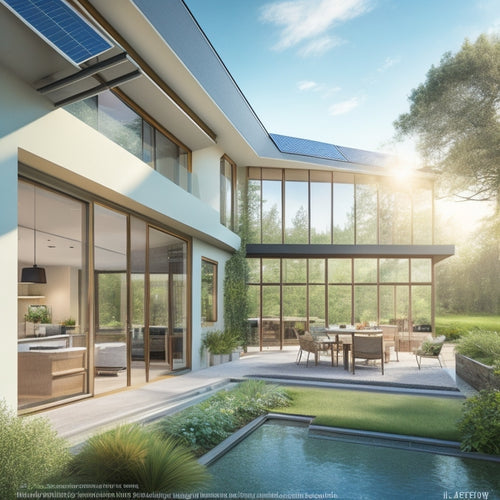
Why Vertical Gardens Energize Green Urban Living?
Share
You're about to experience a significant alteration in urban living as vertical gardens breathe fresh life into cities, revitalizing public spaces, and encouraging a deeper connection with nature. By integrating green roofs, living walls, and urban parks, you'll improve air quality, mitigate the urban heat island effect, and create habitats for local wildlife. You'll also support eco-friendly transportation, renewable energy adoption, and sustainable food production, leading to increased food security, community well-being, and reduced carbon footprints. As you examine the world of vertical gardens, you'll uncover even more innovative solutions that will transform the way you live in harmony with nature.
Key Takeaways
- Vertical gardens integrate renewable energy sources, like solar panels, to promote sustainable urban living and reduce reliance on traditional grids.
- By maximizing urban space, vertical gardens enable local food production, reducing transportation emissions and increasing food security.
- Green walls in vertical gardens enhance air quality, mitigate the urban heat island effect, and create habitats for local wildlife.
- Vertical gardens provide insulation, reducing energy consumption and promoting eco-friendly urban living solutions.
- They also contribute to improved mental health and well-being by providing access to green spaces and nature in urban areas.
Urban Spaces Transformed by Nature
Concrete high-rises, once devoid of life, now teem with verdant walls, as urban spaces undergo a significant change.
You're witnessing the fusion of nature integration and urban biodiversity, where once-barren cityscapes are now lively ecosystems. This alteration not only revitalizes urban aesthetics but also enhances air quality, mitigates the urban heat island effect, and provides habitats for local wildlife.
By incorporating green roofs, living walls, and urban parks, cities are reborn as thriving environments that promote ecological balance and human well-being.
With the integration of sustainable charging solutions, cities can further reduce their carbon footprint and support eco-friendly transportation. As electric vehicles become increasingly popular, green energy charging infrastructure becomes a vital aspect of urban planning.
As you traverse these revitalized spaces, you'll experience the harmonious coexistence of nature and infrastructure, where freedom to breathe, think, and thrive is redefined.
Harnessing Renewable Energy Locally
As you investigate these revitalized urban spaces, you're likely to notice a shift in the way energy is generated and consumed.
Vertical gardens are increasingly incorporating solar integration, allowing buildings to utilize renewable energy locally. This decentralized approach to energy production enhances energy efficiency, reducing reliance on grids and minimizing carbon footprints.
By employing rooftop spaces for solar panels, urban dwellers can generate clean energy on-site, powering their homes and businesses sustainably. Furthermore, this setup attracts eco-conscious consumers, increasing foot traffic and business opportunities commercial EV charging station benefits.
Regular maintenance, including cleaning, is essential for solar panel performance and energy efficiency. This localized energy production not only reduces energy costs but also increases independence from traditional energy providers, giving individuals greater control over their energy needs.
Green Walls for Healthy Cities
How can urban planners and designers reinvent the urban terrain to prioritize residents' well-being? By incorporating green walls, you can create healthier cities.
These vertical gardens improve air quality by absorbing pollutants, reducing particulate matter, and releasing oxygen. They also enhance biodiversity by providing habitats for urban wildlife, supporting local ecosystems, and increasing species diversity.
Additionally, integrating renewable energy sources, such as solar power, can further minimize the carbon footprint of urban infrastructure, promoting sustainability and environmental responsibility.
Sustainable Food Production Methods
By integrating green spaces into urban infrastructure, you're not only improving air quality but also creating opportunities for sustainable food production. You can cultivate fresh produce locally, reducing reliance on industrial agriculture and transportation. Vertical farming and community gardens are innovative solutions that maximize space and minimize environmental impact.
| Benefits | Description |
|---|---|
| Increased Food Security | Access to fresh, locally grown produce |
| Reduced Carbon Footprint | Minimized transportation and packaging |
| Community Engagement | Opportunities for social connection and education |
| Improved Air Quality | Urban gardens absorb CO2 and pollutants |
| Diversified Urban Ecosystem | Habitats for beneficial insects and wildlife |
Eco-Friendly Urban Living Solutions
Integrating eco-friendly urban living solutions into your daily routine can greatly reduce your environmental footprint. By incorporating vertical gardening benefits, you'll not only purify the air and improve mental health but also enhance urban biodiversity.
This innovative approach allows you to grow your own food, reducing reliance on industrial agriculture and transportation emissions. Additionally, vertical gardens provide insulation, decreasing energy consumption and urban heat island effects.
As you adopt these eco-friendly solutions, you'll experience a sense of freedom and empowerment, knowing you're contributing to a sustainable future. By embracing urban biodiversity enhancement, you'll create a thriving ecosystem, supporting local wildlife and nurturing a deeper connection with nature.
In addition, incorporating solar-powered charging solutions and energy storage systems can optimize energy efficiency, reducing carbon emissions and grid reliance.
Frequently Asked Questions
Can Vertical Gardens Be Installed on Existing Buildings or Only New Ones?
As you ponder the possibility, imagine scaling walls of concrete, and you'll find that vertical gardens can be installed on both new and existing buildings, but be prepared to tackle installation challenges and work around existing infrastructure.
How Do Vertical Gardens Impact Urban Air Quality and Pollution?
As you integrate vertical gardens into urban settings, you'll notice a significant reduction in air pollution, thanks to enhanced air purification, and a mitigation of urban heat, ultimately freeing your city from toxic air and scorching temperatures.
Are Vertical Gardens More Expensive Than Traditional Gardening Methods?
When you compare costs, you'll find that vertical gardens require a higher initial investment, but they offer long-term savings through reduced water and land use, making them a smart choice for urban dwellers seeking freedom from traditional gardening constraints.
Can Vertical Gardens Be Adapted for Use in Small, Indoor Spaces?
Like a puzzle piece, you can fit a vertical garden into even the smallest indoor space, leveraging space-saving solutions that enhance indoor aesthetics, allowing you to cultivate freedom and flexibility in your own mini-urban oasis.
Do Vertical Gardens Require Specialized Maintenance or Care?
You'll find that vertical gardens demand attention to plant selection, ensuring ideal growth, and innovative irrigation techniques, like hydroponics or misting, to conserve water and minimize upkeep, granting you the freedom to enjoy your green space with ease.
Related Posts
-

10 Best WiFi Outlets for Tracking Home Energy Usage
You can optimize your home's energy usage with the right WiFi outlets, which provide real-time monitoring and control...
-

5 Efficient Air Circulation Methods for Green Homes
You can utilize the power of natural ventilation techniques, whole house fans, and solar-powered ventilation systems ...
-

5 Ways Geothermal Power Boosts Electric Vehicle Efficiency
You're likely unaware that geothermal power can greatly enhance your electric vehicle's (EV's) performance, range, an...


